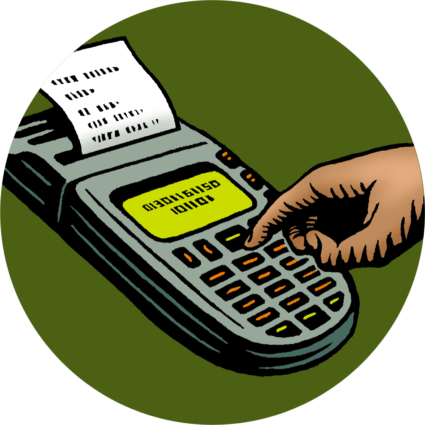Receipt System

Receipt System
For markets that want to operate a centralized POS device but do not want to create and administer a market currency, one alternative is a “receipt system.”
Here’s how the receipt system works:
- The SNAP customer selects SNAP-eligible items for purchase and brings these items to the vendor’s checkout.
- The vendor tallies the total sale and writes a receipt for the customer that features the vendor’s name, the items purchased, and the amount of the purchase.
- The vendor holds the SNAP shopper’s purchase while the shopper brings the vendor’s receipt to the operator of the market’s POS device.
- The operator swipes the shopper’s SNAP EBT card for the amount of the purchase indicated on the vendor’s receipt, provides the customer with a sales receipt, and then signs the vendor’s receipt for proof of purchase. The SNAP funds transfer from the customer’s SNAP account to the market’s bank account tied to the POS device. Note: under SNAP rules, farmers markets and direct marketing farmers are required to provide a printed receipt to their SNAP customers. However, FNS has authorized some third-party processors to allow their customers to provide receipts via email or text message. Ask your third-party processor what your options are.
- The customer returns to the vendor and exchanges their signed vendor receipt for their purchased items. (The customer retains the sales receipt received from the market’s POS device operator.)
- How does the market pay the vendor for receipt system transactions?
- Is a market-administered system with a receipt system right for my market?
- What legal responsibilities do markets assume when they operate a centralized POS device and a receipt system?
-
How does the market pay the vendor for receipt system transactions?
After the market, the vendor submits their signed vendor receipts to the market manager or individual responsible for handling the market accounts. This individual then conducts the necessary accounting and provides the vendor with a check in accordance with the market’s reimbursement schedule.
Back to questions
-
Is a market-administered system with a receipt system right for my market?
It depends. Consider the advantages and disadvantages below:
Farmers Markets
Advantages Disadvantages Enables markets to expand access to local foods, increase market accessibility within the community, and potentially increase market and vendor revenue. Cost of implementing system (POS equipment & fees, currency materials, labor, administration, accounting, etc.). Note: free SNAP EBT POS equipment may be available in your state. Check with the Farmers Market Coalition(FMC) and/or your state or regional association. Provides the market with an extensive paper trail of SNAP transactions, which could be useful in the market’s accounting and documentation. Market is liable and subject to penalties for illegal SNAP transactions (even those by vendors). More cost-efficient than scrip system. (Cheaper than purchasing tokens and nothing of value, like tokens, to lose.) Vendors
Advantages Disadvantages Potential increase in sales (to SNAP-eligible customers who might not otherwise shop at the market). Transactions may be inefficient and cumbersome. Vendors must keep paper receipts for reimbursement. Reimbursement for SNAP transactions is not always immediate. Customers
Advantages Disadvantages SNAP customers may purchase foods from all vendors selling SNAP-eligible items, regardless of whether the vendor has their own POS device. Transactions may be inefficient and cumbersome. Unlike in scrip systems, SNAP customers can spend precise SNAP dollar amounts and not risk losing funds because they don’t receive change when their purchases come out to less than the whole scrip denomination. If a market chooses to use a receipt system and accept only SNAP benefits (not credit/debit), it draws unique and perhaps undesirable attention to SNAP customers. To customers, the receipt system may feel unfamiliar or uncomfortable.
Back to questions
-
What legal responsibilities do markets assume when they operate a centralized POS device and a receipt system?
The legal responsibilities of a market operating a receipt system with a centralized POS device are similar to those of a market operating a scrip system. See that discussion in question 5 of the previous tab.
Back to questions
